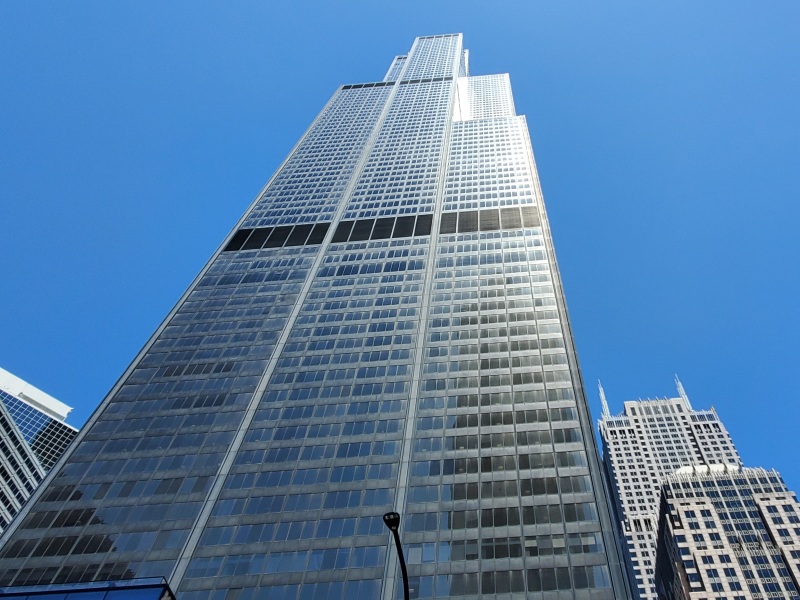 Willis (formerly Sears) Tower
Willis (formerly Sears) Tower
233 South Wacker Drive
Skidmore Owings & Merrill, architects
Skidmore Owings & Merrill, architects
Audio Tour
Walk south, returning to Jackson Boulevard, then turn west -- or right. On Jackson, walk two blocks -- crossing Franklin Street -- to Willis (formerly Sears) Tower.
Designed by architect Bruce Graham and engineer Fazlur Rahman Khan of Skidmore Owings & Merrill, the building is creatively comprised of nine square "tubes", clustered in a 3-by-3 matrix with seven of the tubes set back at upper floors. The building's facade is made of anodized aluminum and black glass.
The base of the building contains a retail area, with the upper floors comprised of offices. The lower half of the tower was originally occupied by Sears -- then the largest retailer in the world -- as its headquarters. Although Sears moved from the building in 1994, it remained Sears Tower until the naming rights were included in a 2009 lease with the Willis Group.
Willis Tower stands at 110 stories and 1,450 feet tall -- over one-quarter mile! When opened in 1973, the building was the world's tallest building. Today, it is the third tallest building in the Western Hemisphere, behind One World Trade Center (at 1,775 feet) and Central Park Tower (at 1,549 feet) -- both in New York. When Willis Tower lost its title in 2014 to One World Trade Center, the spire on One World Trade Center made the difference -- spires are counted towards a building's height while antennas are not! Willis Tower still has the highest occupied floor at 110 -- versus 104 for One World Trade Center and 98 for Central Park Tower.
For more information on Willis Tower, tap the blue button on this page.
A “must do” while in Chicago is a trip to Willis Tower's 103rd floor observation deck called Skydeck. Before the trip up the high-speed elevator, you’ll view a brief film on the construction of the building. The views from the top are spectacular, and it’s a great way to conclude your day of sightseeing in the Loop.
Congratulations! It's been quite a journey, and you've completed our Loop Architecture tour. We hope you enjoyed learning about some of Chicago's spectacular buildings and public art. To return to our main menu of free, self-guided walking tours, tap the "Home" button below.
Designed by architect Bruce Graham and engineer Fazlur Rahman Khan of Skidmore Owings & Merrill, the building is creatively comprised of nine square "tubes", clustered in a 3-by-3 matrix with seven of the tubes set back at upper floors. The building's facade is made of anodized aluminum and black glass.
The base of the building contains a retail area, with the upper floors comprised of offices. The lower half of the tower was originally occupied by Sears -- then the largest retailer in the world -- as its headquarters. Although Sears moved from the building in 1994, it remained Sears Tower until the naming rights were included in a 2009 lease with the Willis Group.
Willis Tower stands at 110 stories and 1,450 feet tall -- over one-quarter mile! When opened in 1973, the building was the world's tallest building. Today, it is the third tallest building in the Western Hemisphere, behind One World Trade Center (at 1,775 feet) and Central Park Tower (at 1,549 feet) -- both in New York. When Willis Tower lost its title in 2014 to One World Trade Center, the spire on One World Trade Center made the difference -- spires are counted towards a building's height while antennas are not! Willis Tower still has the highest occupied floor at 110 -- versus 104 for One World Trade Center and 98 for Central Park Tower.
For more information on Willis Tower, tap the blue button on this page.
A “must do” while in Chicago is a trip to Willis Tower's 103rd floor observation deck called Skydeck. Before the trip up the high-speed elevator, you’ll view a brief film on the construction of the building. The views from the top are spectacular, and it’s a great way to conclude your day of sightseeing in the Loop.
Congratulations! It's been quite a journey, and you've completed our Loop Architecture tour. We hope you enjoyed learning about some of Chicago's spectacular buildings and public art. To return to our main menu of free, self-guided walking tours, tap the "Home" button below.
HELP KEEP OUR TOURS FREE!
(Optional Donation)
(Optional Donation)